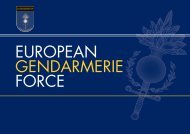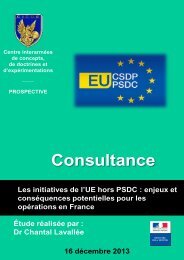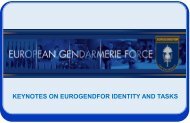Conference
science-research-bulletin-2013-conference
science-research-bulletin-2013-conference
Create successful ePaper yourself
Turn your PDF publications into a flip-book with our unique Google optimized e-Paper software.
EUROPEAN POLICE SCIENCE AND RESEARCH BULLETIN<br />
SPECIAL CONFERENCE EDITION<br />
The police modus operandi involved contacting<br />
key organisers, such as SACA personnel and the<br />
presidents of the Sheffield Hallam University and<br />
University of Sheffield student unions. The SACA<br />
representative was personally escorted round the<br />
proposed route of the march, and the perceived<br />
merits similarly explained (in bunches of five) to<br />
student union officers during visits by the trained<br />
negotiators:<br />
‘But that’s undoubtedly where the skill and the craft<br />
of the liaison team came to the fore, because it was<br />
about them saying: “Well, actually, if we take you<br />
down Fitzwilliam Street, you go along Charter Row,<br />
down onto Pinstone Street, you’re going past the<br />
seat of democracy in Sheffield, the Town Hall; you’ve<br />
got a longer march route, so you’re going to get more<br />
people seeing and hearing what you’re protesting<br />
about and guarantee prime locations for the media to<br />
be able to pick up and monitor what you’re doing”’.<br />
(Interview, Negotiator Co-ordinator)<br />
The ‘guided tour’ accorded to the SACA<br />
representative also provided an opportunity<br />
for police intelligence-gathering and for the<br />
two parties to learn of each other’s intentions:<br />
‘All through the route, we were just chatting<br />
about the policing, what they expected of us,<br />
what we expected of them, and basically he<br />
was picking my brain for how many numbers<br />
we expected, and quite reasonable things such<br />
as what we expected might happen’ (Interview,<br />
SACA Representative). The police also used<br />
existing communication channels between Safer<br />
Neighbourhood officers and the students’ union<br />
to accumulate similar intelligence and insight:<br />
‘We agreed to this, and he came and asked us:<br />
one, what we had planned for the event; and<br />
two, whether we had any idea what other groups<br />
might be planning for it. I’m signed up to a lot of<br />
databases with various cuts movements and things,<br />
so we made a point of relaying to the police any<br />
information arising from emails, and that sort of<br />
thing, that we thought might be relevant. We have<br />
an open line with the police all year round and we<br />
always feel that we can talk to them in confidence,<br />
and vice-versa, so it was all about keeping that<br />
dialogue open with them’. (Interview, Sheffield<br />
Hallam University SU President)<br />
Equivalent questions were asked of the University<br />
of Sheffield SU President, who was able to<br />
provide some helpful observations, based on<br />
the appearance of graffiti, leaflets and online<br />
communication, of the intentions of participating<br />
groups which had chosen not to liaise with the<br />
police. The content and tone of such discussions<br />
helped reassure the police that the students<br />
unions were out to avoid and, indeed, distance<br />
themselves from the type of violent protest<br />
that had been witnessed during the London<br />
demonstration:<br />
‘We certainly had groups who weren’t that open<br />
in their communication and were quite covert in<br />
their ambitions, so there was always that element<br />
of the unknown. But overall, we felt pretty secure<br />
from meeting their representatives that we knew<br />
just how 80 per cent of the people wanted the<br />
protest to turn out…. The brief was to come up with<br />
a way to communicate more effectively with the<br />
protest groups… to show that, as a police service,<br />
we’d made a measured approach and been sort of<br />
proportionate. If people then chose not to listen to<br />
what we were asking them to do to work together<br />
with us in what we were trying to achieve, then we’d<br />
at least have some legitimacy for any more robust<br />
police action that might eventually prove necessary’.<br />
(Interview, Negotiator Co-ordinator)<br />
As part of their ‘no surprises’ approach, PLT officers<br />
asked organisers whether any of the proposed<br />
police tactics made them feel uncomfortable<br />
or might risk worrying or aggravating their<br />
constituents. The police emphasised how<br />
they wanted to avoid kettling at all costs, but<br />
maintained that, should the need ever arise,<br />
liaison officers would immediately appear to set<br />
the innocent free. The PLT Bronze presented each<br />
organiser with his card and maintained regular<br />
contact in the days leading up to the protest. A<br />
further example of this strong ‘personal touch’<br />
was his assurance to the Hallam union president<br />
that, ‘If I ever found myself in a kettle, I could<br />
give him a ring and he’d personally come and let<br />
me out’ (Interview, Sheffield Hallam University<br />
SU President).<br />
The Hallam SU branch had recently received a<br />
statement by a group which threatened to smash<br />
up the union building because they had been<br />
refused permission to stage a conference there<br />
on the day of the protest. The moment the police<br />
became aware of this they assigned officers to<br />
guard the building. This underlying commitment<br />
to building rapport and establishing the basis of<br />
an exchange relationship was further evident in<br />
the PLT’s undertaking to set up a sound system for<br />
one group of protesters which would otherwise<br />
have been banned from the protest.<br />
37





